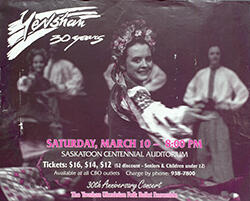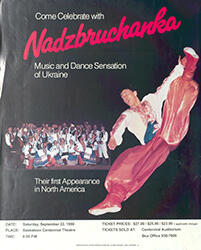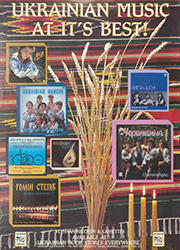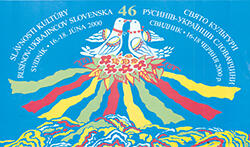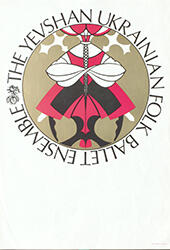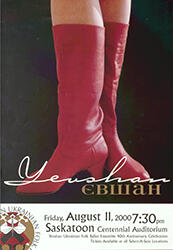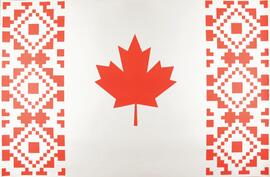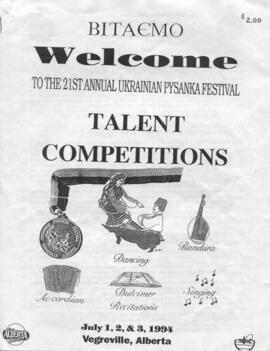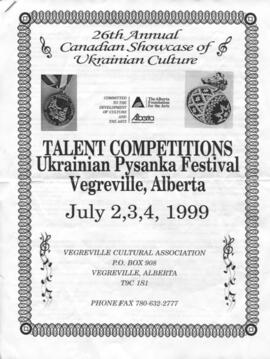Poster advertising events for SUSK at the University of Toronto. August 24-30, 1973.
Poster advertising for the "Ranch Boys". According to the advertisement, they received radio play. Wally Yanchyski (steel guitar), Al Tokaryk (accordion), Mike Chwaluk (fiddle), Hank Norman (rhythm guitar), Joe Rozdeba (drums). Poster includes a photograph of the band.
Poster advertising for the Vesna Festival. Event to take place May 13 and 14, 1988. Featuring the Romaniacs (band). Other details of the event on the poster.
Poster advertising for The Yevshan Ukrainian Folk Ballet Ensemble's 30th anniversary concert. Concert on March 10 in Saskatoon, Saskatchewan.
Poster advertising for Folkfest 1992 in Saskatoon, Saskatchewan. Event August 20-22, 1992.
Posters advertising a performance by the music and dance company Nadzbruchanka in their first North American appearance. Posters advertise for different locations and dates.
Poster in Ukrainian advertising for an event. Event by the Ukrainian World Congress.
Poster advertising for the Ukrainian Broadcasting Network, owned by DirectTV.
Poster advertising for Ukrainian music published by Yevshan Records.
Poster advertising for a cultural event on June 16-18, 2000. Ukrainian text reads "Sviato Kul'tury Rusyniv-Ukraintsiv Slovachchyny Svydnyk".
Poster advertising for the Yevshan Ukrainian Folk Ballet Ensemble.
Poster advertising a performance by Yevshan in Saskatoon, Saskatchewan. Event to take place August 11, 2000.
Poster showcasing the Canadian flag as if it were embroidered.
СЕЛО. Cultural Immersion Camp
A C.Y.M.K Program
Camp Krym - Gamebridge, Ontario
August 12-31, 1984
The collection consists of field research materials collected by Mariya Lesiv as part of her research during doctorate studies at the Ukrainian Folklore Program, University of Alberta, and a copy of her dissertation entitled "Modern Paganism between east and west: construction of an alternative national identity in Ukraine and the Ukrainian diaspora." 15 mini-DVs contain field video, 10 CDs - photographs, documenting rituals and interviews with Pagans in both Ukraine and North America.
Dissertation abstract:
Modern Ukrainian Paganism is a new religious movement that draws upon beliefs and practices from over a thousand years ago. It represents a mode of resistance to both the political oppression of Ukraine and the dominant position of Christianity in that country. Paganism spread among the urban Ukrainian intelligentsia in the North American diaspora after World War II, and developed actively in Ukraine after the collapse of the Soviet Union. Today, while experiencing a great decline in the diaspora, it is rapidly growing in Ukraine, involving many different Pagan communities and thousands of believers.
Pagans draw on a variety of sources including both historical chronicles containing information about old Slavic mythology and contemporary rural folklore that is believed to maintain remnants of the old pagan worldview. Although many folkloric forms have been appropriated by the Christian church, contemporary Pagans consider these elements to have originated in pre-Christian times and reclaim them for their own needs.
This work is the first extended study of Ukrainian Paganism in its post-Soviet East European context and in the North American diaspora, simultaneously comparing it with Western Paganism. It is based on ethnographic fieldwork, including participant observation of rituals and interviews with Pagans in both Ukraine and North America, as well as on archival and published materials.
While focusing predominantly on the revival of pagan folklore within this movement, this thesis demonstrates how the imagined past has become important for constructing an alternative national identity in modern contexts of socio-political turmoil. The thesis suggests that this cultural revival often has little to do with historical reality, since there is limited primary information available. Like other revivals, it involves the construction of new cultural forms through creative interpretations of the ancestral past. Moreover, the obscurity of the past allows individualistic interpretations that result in many variations of similar forms. These forms are examined in their relationship to the concepts of nationalism, gender, charisma and power, religious syncretism, and aesthetics. This work is multidisciplinary in nature as it draws upon theoretical frameworks developed in fields of folkloristics, anthropology, sociology, cultural studies and art criticism. It contributes to the understanding of modern cultural processes that shape the national consciousness of people in various parts of the world.
Untitled


